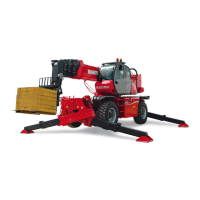1-28
P
Quando l'indicatore di stato di carico è in
allarme, non bisogna in alcun caso:
A - Far uscire il braccio.
B - Abbassare il braccio.
- Se l'indicatore di stato di carico è in
allarme, effettuare i movimenti sgravanti,
nel seguente ordine (Fig. P) :
1 - Rientrare il braccio al massimo.
2 -Se necesario alzare il braccio
3 - Abbassare il braccio in modo da
posare il carico.
Carrello elevatore con correttore
d’inclinazione.
- Correggere l’inclinazione, agendo sul
comando idraulico e verificare
l’orizzontalità sulla livella prima di
sollevar il bracio(Vedi capitolo :
STRUMENTI DI CONTROLLO E DI
COMANDO, nella parte : 2 -
DESCRIZIONE).
Oltre alla pendenza trasversale del
terreno, altri parametri possono incidere
sull’orizzontalità del carrello elevatore.
• Lo stato e la pressione dei pneumatici.
• La stabilità del terreno.
• L’equilibrio del carico.
• Il vento forte o la tempesta.
Prima di ogni movimentazione, controllare
le condizioni sopraelencate e verificare
che il carrello elevatore sia
perfettamente
orizzontale
.
(Controllare sulla livella a bolla)
it
If the load status indicator alarm is acti-
ved, do not carry out the movements said
to be "WORSENING", which are the fol-
lowing :
A - Extend the jib.
B - Lower the jib.
- If the load status indicator alarm is
actived, carry out in all security move
ments in the following order (Fig. P) :
1 - Fully retract the jib.
2 - If it’s necessary lift the jib
3 - Lower the jib in order to lay the load.
Lift truck with level corrector
- Correct the slope using the hydraulic
control and check the horizontal position
on the level before lifting the boom(See
chapter : INSTRUMENTS AND CONTROLS
in paragraph : 2 - DESCRIPTION).
Apart from the transverse slope of the
ground, several parameters can upset the
horizontal position of the lift truck.
• The tyre pressures.
• The stability of the ground.
• The balance of the load.
• Strong wind or stormy conditions.
Before any handling work, check the
points above and ensure that the lift truck
is
completely horizontal
.
(See bubble level)
en
Jeśli wskaźnik stanu ładunku włączy
alarm, pod żadnym pozorem nie należy:
A - Wysuwać wysięgnika.
B – Opuszczać wysięgnika.
- Jeśli wskaźnik stanu ładunku włączy
alarm, wykonać ruchy odciążające w
następującej kolejności (Rys. P):
1 – Zsunąć całkowicie wysięgnik.
2 – W razie potrzeby podnieść wysięgnik.
3 – Obniżyć wysięgnik w sposób
pozwalający na odłożenie ładunku.
Wózek podnośnikowy z korektą
nachylenia.
- Nachylenie koryguje się za pomocą
hydraulicznego urządzenia korygującego.
Przed podniesieniem wysięgnika
sprawdzić na poziomicy ustawienie w
poziomie (patrz rozdział:PRZYRZĄDY
KONTROLNE I STERUJĄCE w części:2 -
OPIS).
Oprócz poprzecznego nachylenia terenu,
na ustawienie wózka podnośnikowego w
poziomie mogą wpływać również inne
parametry.
• Stan i ciśnienie w oponach.
• Stabilność terenu.
• Wyważenie ładunku.
• Silny wiatr lub burza.
Przed każdym przeniesieniem ładunku
skontrolować ww. warunki oraz sprawdzić
czy wózek podnośnikowy stoi
idealnie w
poziomie
.
(Sprawdzić poziomicę)
pl
648870 IT-EN-PL (04/05/2015)

